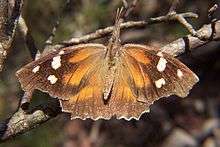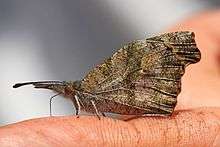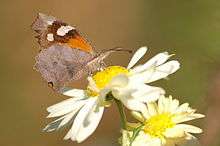American snout
The American snout or common snout butterfly (Libytheana carinenta) is a member of the subfamily Libytheinae in the brush-footed butterfly family, Nymphalidae. This species is found in both North and South America. The larval host plants are Celtis species on which the eggs are laid singly. Massive migrations of this species often attract attention in the Texas and Mexican newspapers.


| American snout | |
|---|---|
 | |
| Scientific classification | |
| Kingdom: | Animalia |
| Phylum: | Arthropoda |
| Class: | Insecta |
| Order: | Lepidoptera |
| Family: | Nymphalidae |
| Genus: | Libytheana |
| Species: | L. carinenta |
| Binomial name | |
| Libytheana carinenta (Cramer, 1777) | |
| Synonyms | |
|
Libytheana bachmanii Kirtland, 1851 | |
Snout butterflies have prominent elongated mouthparts (labial palpi) which, in concert with the antennae, give the appearance of the petiole (stem) of a dead leaf. Snouts often take advantage of this superb camouflage by hanging upside down under a twig, making them nearly invisible. Wings are patterned black-brown with white and orange markings. The forewings have a distinctive squared off, hook-like (falcate) tip.
The caterpillars appear humpbacked, having a small head, swollen first and second abdominal segments, and a last abdominal segment which is tapered and rounded. They are dark green with yellow stripes along the top and sides of the body, and have two black tubercles on the top of the thorax. Their food is the common hackberry (Celtis occidentalis) tree.[1]
This species is known to be migratory, and some years the migrations are huge.[2]
References
- American Snout, Butterflies of Canada
- TAMU
External links
- Tree of Life Libytheinae
- American Snout Butterfly: Reference quality large format closeup photographs Cirrus Digital Imaging
- American snout on the UF / IFAS Featured Creatures website